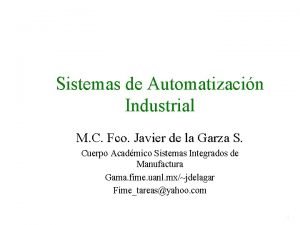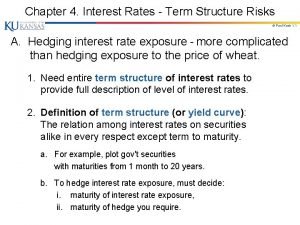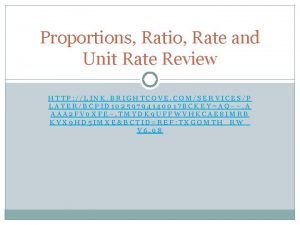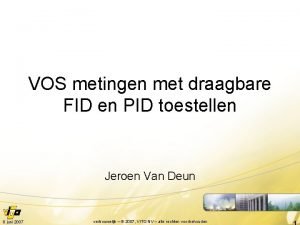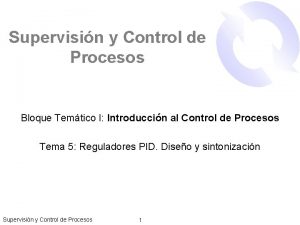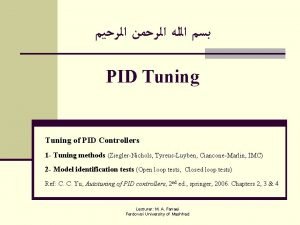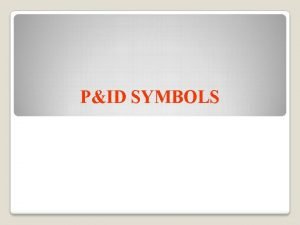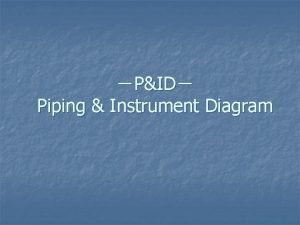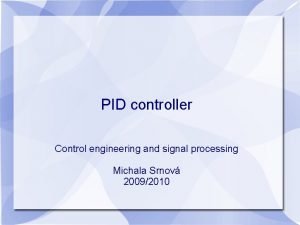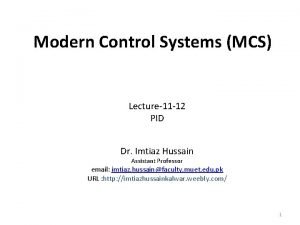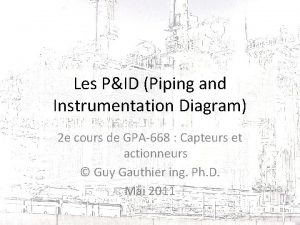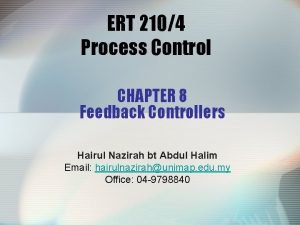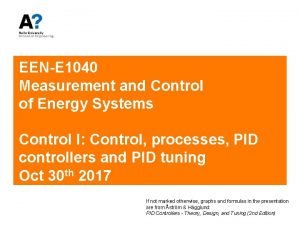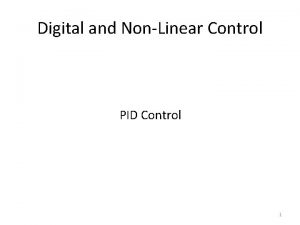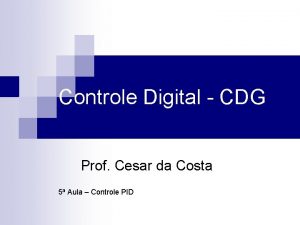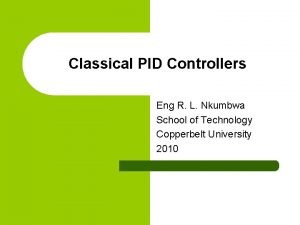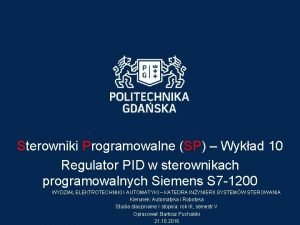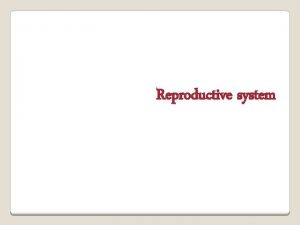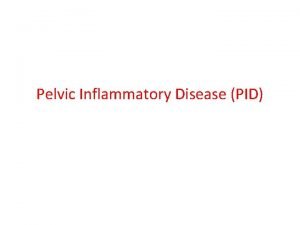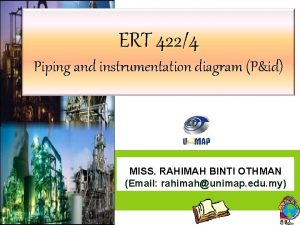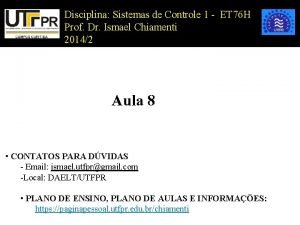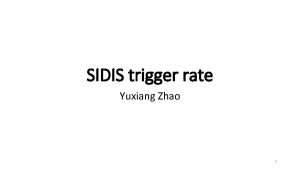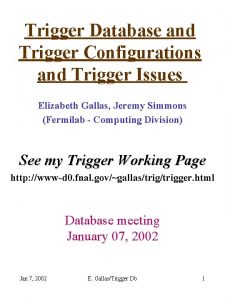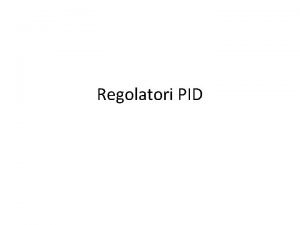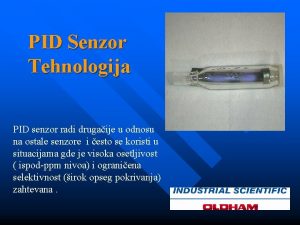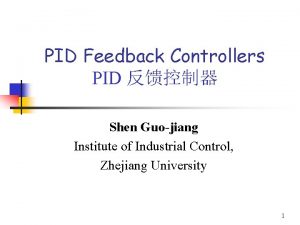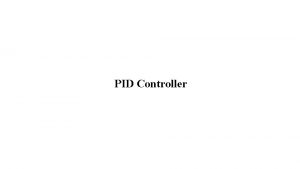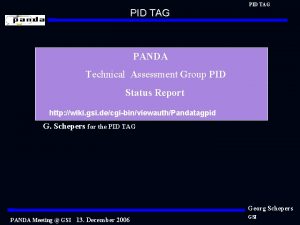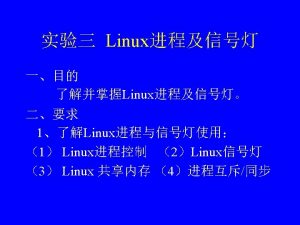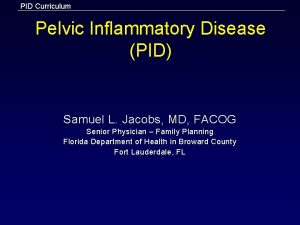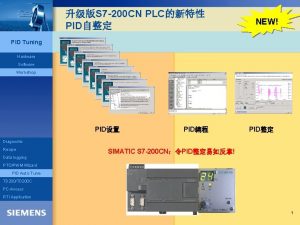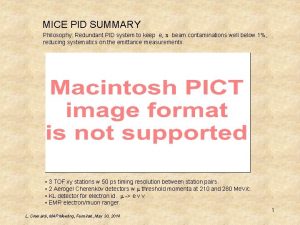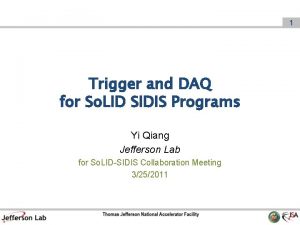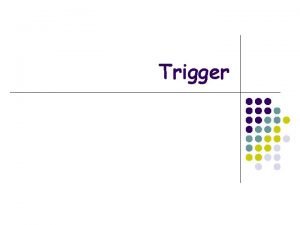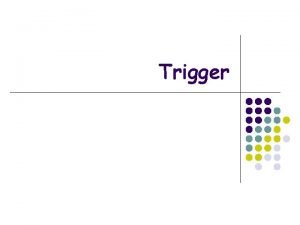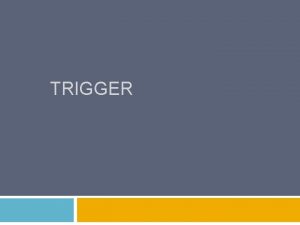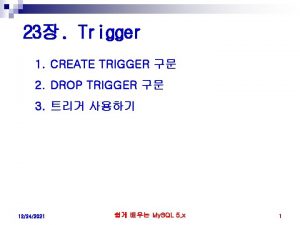SIDIS Trigger Rate and PID Update SIDIS trigger
















![SIDIS trigger rates Update Single e (e_FAEC[e, h]+e_LAEC[e, h]): 128. 1 k. Hz>100 k. SIDIS trigger rates Update Single e (e_FAEC[e, h]+e_LAEC[e, h]): 128. 1 k. Hz>100 k.](https://slidetodoc.com/presentation_image_h2/0eedfe0d0254636f38758f921fcdf47c/image-17.jpg)












- Slides: 29

SIDIS Trigger Rate and PID Update ØSIDIS trigger rate summary ØSIDIS trigger rate updates for HGC window thickness ØPID summary (need to be updated) Ye Tian Syracuse University

SIDIS Trigger Rates Updates with 3 Ge. V trigger threshold for LAECAL Rate (k. Hz) Ecal+LGC(2, 2)+SPD(>0. 425 Me. V) 7 modules 3 Ge. V trigger threshold for LAEC +Up window+ down widow FA e- 60+1. 1+1. 8 FA hadron no e- 29+3. 6+5. 3 LA e- 4. 1+3. 6+2. 6 LA hadron no e- 7. 7+6. 5+3. 8 hadron trigger SIDIS coin Hadron coin Total rate 8013+2591+3887 31. 2 14. 7+2. 52+2. 61=19. 83 <85 k. Hz (30 ns time window)

SIDIS HGC Window Thickness window thickness all in cm front original )0. 04 Kevlar) real )0. 24 CF) back 0. 10(Al( 0. 64(Al( Ø What’s the influence of the changing on the SIDIS trigger rate? Ø What’s the influence of the changing on the PID performance ( p rejection)?

Electron Ecal Response 1. 05 -1. 15 m 1. 15 -1. 3 m Flux p at EC front plane 1. 3 -1. 5 m 1. 5 -2. 0 m Electron hit on Ecal from vertex directly e. DIS all detectors All radius

Evenly distributed Electron 6 p 1 Ecal Deposit E 0. 9 -1. 05 m 1. 05 -1. 15 m 1. 15 -1. 3 m 1. 3 -1. 5 m 1. 5 -2. 0 m

Single e- Trigger Rates Rate (k. Hz) FAEC+LGC+SPD Original e- 70. 4(58. 4) 65. 0(57. 9) 60. 0(54. 4) Real e- 68. 1(54. 6) 70. 4(56. 4) 71. 92(57. 57) 62. 7(54. 2) 64. 98 (56. 0) 66. 12(57. 10) Original p 0 519. 7(59. 27 ) 22. 13(15. 98) Real p 0 508. 65(67. 25) 20. 122(14. 1) 57. 9(50. 8) [-3. 3(6. 5)%] 59. 97(52. 5) 61. 03(53. 50) [-1. 6%] 16. 6(15. 08) 14. 93(13. 38) Original p- 656(584. 5) 3. 97(3. 4) 3. 56(3. 13) Original p 250(226. 8) 0(0) ( ) means that count particle from vertex, for p 0 ( ) means e- or e+ hit on Ecal Lower Ecal threshold by 3. 3%, Lower Ecal threshold by 6. 5%

Single e- Trigger Rates Rate (k. Hz) FAEC+LGC+SPD Original all 1934. 47 hadrons no e 34. 74 26. 58 Real all 1904. 2 hadrons no e 2080. 86 2157. 5 32. 1 35. 84 37. 13 24. 4 27. 49 28. 60 (+6. 5%) Original total FAECAL 2004. 9 99. 3 86. 58 Real total FAECAL 2229. 4 103. 3 89. 6 (+3. 6%) Lower Ecal threshold by 3. 3%, Lower Ecal threshold by 6. 5%

Hadron Trigger Rates h_FA (k. Hz) EC EC+SPD Original e- 135. 8(92) 96. 7(85) Real e- 130. 5(90. 5) 96. 7(83. 3) Original p 0 2269. 61(376. 0) 259. 25(216. 0) Real p 0 2251. 2 (430. 97) 328. 891(278. 96) Original all hadrons no e- 10066. 7 7511. 69 Real all hadrons no e- 9970. 9 (-0. 09%) 7518. 66(+0. 09%) We can keep the hadron trigger as 4 s of the MIP cut !

MIP 6 p 1 Ecal Deposit E 0. 9 -1. 05 m 1. 15 -1. 3 m 1. 5 -2. 0 m 1. 05 -1. 15 m 1. 3 -1. 5 m 4 s of MIP peak cut

SIDIS Total Trigger Rates Updates (3 Ge. V trigger threshold for LAECAL) Rate (k. Hz) Original Ecal+LGC(2, 2)+S +Up window+ down widow PD(>0. 425 Me. V) FA e. FA hadron no e. LA e- 60+1. 1+1. 8 61. 03+2. 95 26. 58+3. 6+5. 3 28. 60+9. 48 4. 1+3. 6+2. 6 LA hadron no ehadron trigger SIDIS coin Hadron coin Total rate HGC real s E ry 7. 7+6. 5+3. 8 ina lim e r P y r 7611. 69+2591+3887 Ve n o i t same it ma same 7618. 66+6483. 8 31. 2 same 14. 7+2. 52+2. 61=19. 83 same <83 k. Hz <84. 7 k. Hz [+2%] Based on the current simulation files and bggen event generator !

Offline PID performance FAECAL 8. 5 o< q<13. 85 o Ecal only + beam on target background We need new simulation files to updated the results !

Offline PID performance FAECAL Ecal only + beam on target background p rejection>50: 1 We need new simulation files to updated the results !

Summary and To-do The HGC window thicker thickness will increase the total trigger rate by 2% (<100 k. Hz), when we keep the vertex electron efficiency > 93. 4%. If need, we could further lower the threshold to achieve electron efficiency > 95%. The influence of the HGC window thickness need to be finalized with the right simulation files, the current study shows that the pion rejection is better than 50: 1 without the edge effect. With the edge effect, the electron efficiency will be ~10% lower. From the preliminary estimation, changing the HGC window to a thicker material (real) doesn’t bring any potential trouble to the SIDIS total rate.

Backup

Momentum Lost

Momentum Lost
![SIDIS trigger rates Update Single e eFAECe heLAECe h 128 1 k Hz100 k SIDIS trigger rates Update Single e (e_FAEC[e, h]+e_LAEC[e, h]): 128. 1 k. Hz>100 k.](https://slidetodoc.com/presentation_image_h2/0eedfe0d0254636f38758f921fcdf47c/image-17.jpg)
SIDIS trigger rates Update Single e (e_FAEC[e, h]+e_LAEC[e, h]): 128. 1 k. Hz>100 k. Hz Hadron (h_FAEC[e, h]): 14491 k. Hz Random coin: assuming no correlation between electron and hadron trigger: (e_FAEC[e, h]+e_LAEC[e, h])*(h_FAEC[e, h])*time window (30 ns) v SIDIS coin (Duke e- hadron generator) v Hadron coin (Bggen genertor) Has overlap, and how much?

Electron Trigger Efficiency e. DIS Reduce 185. 87 Me. V to 165. 87 Me. V

SIDIS electron trigger even e. FAEC electron trigger Radius (cm) 6+1 Cluster Threshold (Me. V) original 3. 3% 6. 5% 90 -105 990. 09 956. 5 925. 5 105 -115 762. 6 736. 7 712. 9 115 -130 557. 97 539. 1 521. 64 130 -150 355. 25 343. 2 332. 12 150 -200 185. 8 179. 6 173. 77 19

Q 2>1 Ge. V 2, and W>2 e. DIS Vertex momentum

Electron Trigger Efficiency

Pion Trigger Efficiency

Single e- Trigger Rates Rate (k. Hz) FAEC+LGC+SPD Original e- 70. 4(58. 4) 65. 0(57. 9) 60. 0(54. 4) Real e- 68. 1(54. 6) 62. 7(54. 2) 57. 9(50. 8) (3. 3(2)%) CO 2 e- 65. 5(50. 1) 69. 36 60. 5(49. 7) 64. 0 56. 2(46. 8) (6. 5%) 59. 2 Original p 0 519. 8 22. 0 16. 53 16. 58 Real p 0 507. 8 559. 9 20. 4 22. 5 15. 0 15. 1 16. 8 CO 2 p 0 484. 1 546. 3 18. 5 21. 2 13. 3 15. 3

SPD Threshold Cut on Trigger Rate From: Sanghwa

Electron Trigger Efficiency E_SPD>0. 5 Me. V e. DIS

Ecal Electron Trigger Response Flux p at EC front plane e. DIS all detectors

Single e- Trigger Rates Rate (k. Hz) FAEC+LGC+SPD Original e- 70. 4(58. 4) 65. 0(57. 9) 60. 0(54. 4) Real e- 68. 1(54. 6) 70. 4(56. 4) 71. 92(57. 57) 519. 8 62. 7(54. 2) 64. 98 (56. 0) 66. 12(57. 10) 22. 0 Original p 0 Real p 0 508. 65(67. 25) 20. 122(14. 1) 572. 76(77. 59) 23. 14(16. 5) 57. 9(50. 8) [-3. 3(6. 5)%] 59. 97(52. 5) 61. 03(53. 50) 16. 53 14. 9339(13. 38) 17. 33(15. 56) [+16%] Original p- 656(584. 5) 3. 97(3. 4) 3. 56(3. 13) Original p 250(226. 8) 0(0)

Q 2>1 Ge. V 2, and W>2 e. DIS EC flux momentum

PID Performance Summary Ø Without background contribution, PID performance (e/pseparation) from both FAEC and LAEC are little better than the Prec. DR results (by ignoring the edge effect) Ø By including the edge effect, the PID performance will be 10%-15% worse than that without the edge effect. Ø With background contribution, PID performance from both FAEC and LAEC are worse than Prec. DR results. >50: 1 π- rejection at 95% e efficiency for p>2 Ge. V/C (FAEC) 22: 1 π- rejection at 70% e efficiency for 1<p<2 Ge. V/C (FAEC) >50: 1 π- rejection at 96% e efficiency for p>4 Ge. V/C and 85%-90% for 2 Ge. V<p<4 Ge. V (LAEC θ[18 o, 22 o]) 29
 Multi loop pid controller regolatore pid multi loop
Multi loop pid controller regolatore pid multi loop Recovery techniques based on immediate update
Recovery techniques based on immediate update “control de grua” and pid
“control de grua” and pid Nominal v. real interest rates
Nominal v. real interest rates Plant growth definition
Plant growth definition Option adjusted spread
Option adjusted spread Spot rate and forward rate
Spot rate and forward rate What is the difference between rate and unit rate
What is the difference between rate and unit rate Pid meter werking
Pid meter werking Perturbaciones
Perturbaciones Sanjay seshan
Sanjay seshan Open office
Open office Piping diagram symbols
Piping diagram symbols Pid symbols
Pid symbols Pid rise time
Pid rise time Pid persistent identifier
Pid persistent identifier Modern control
Modern control Schéma tuyauterie et instrumentation
Schéma tuyauterie et instrumentation Hlyniany
Hlyniany Transfer function of pid controller is
Transfer function of pid controller is Pid rise time
Pid rise time Control pid
Control pid Calculo pid
Calculo pid Classical pid control
Classical pid control Pid compact
Pid compact Premenstrual syndrome discharge
Premenstrual syndrome discharge Pid discharge pictures
Pid discharge pictures Hic p&id
Hic p&id Controle pid
Controle pid Pid controller animation
Pid controller animation


